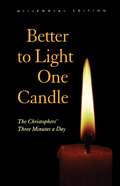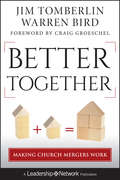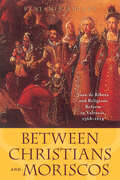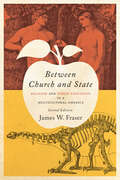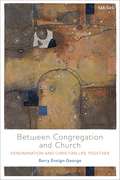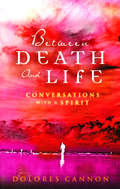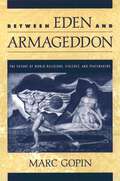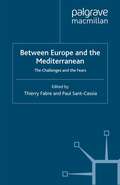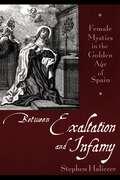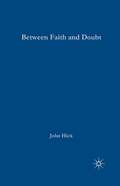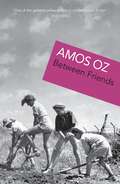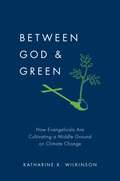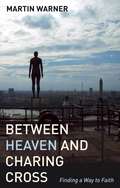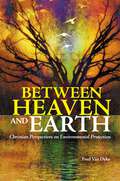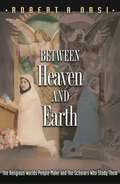- Table View
- List View
Better to Light One Candle: The Christophers' Three Minutes a Day
by The ChristophersWhen Father James Keller founded The Christophers in 1945, he chose an ancient Chinese proverb as the motto, the credo, for the movement: "It's better to light one candle than to curse the darkness". Father Keller wrote the first Three Minutes a Day book of daily reflections in 1949, believing that "the most effective exterior action had to come from a strong interior spirituality".The popular series has continued for fifty years. With a story or anecdote for each day of the year plus a scripture verse and a prayer, each volume offers daily inspiration throughout the year. This is the thirty-fourth volume in the series. It is a collection of some of the best stories from several volumes, and to make it a true perennial, it includes a separate section for twenty-five movable holydays and holidays.
Better Together: Making Church Mergers Work (Jossey-Bass Leadership Network Series #62)
by Jim Tomberlin Warren BirdThousands of Protestant churches are perplexed by plateaued or declining attendance, while other congregations nearby thrive. Is there a way for them to combine forces, drawing on both their strengths, in ways that also increase their missional impact? Church merger consultant Jim Tomberlin, with co-writer Warren Bird, makes the case that mergers today work best not with two struggling churches but with a vital, momentum-filled lead church partnering with a joining church. In this new book, they provide a complete, practical, hands-on guide for church leaders of both struggling and vibrant churches so that they can understand the issues, develop strategies, and execute a variety of forms of merger for church expansion and renewal to reinvigorate declining churches and give them a "second life."
Better Together: Making Church Mergers Work (Jossey-Bass Leadership Network Series #62)
by Jim Tomberlin Warren BirdThousands of Protestant churches are perplexed by plateaued or declining attendance, while other congregations nearby thrive. Is there a way for them to combine forces, drawing on both their strengths, in ways that also increase their missional impact? Church merger consultant Jim Tomberlin, with co-writer Warren Bird, makes the case that mergers today work best not with two struggling churches but with a vital, momentum-filled lead church partnering with a joining church. In this new book, they provide a complete, practical, hands-on guide for church leaders of both struggling and vibrant churches so that they can understand the issues, develop strategies, and execute a variety of forms of merger for church expansion and renewal to reinvigorate declining churches and give them a "second life."
Between Christians and Moriscos: Juan de Ribera and Religious Reform in Valencia, 1568–1614 (The Johns Hopkins University Studies in Historical and Political Science #124)
by Benjamin EhlersIn early modern Spain the monarchy's universal policy to convert all of its subjects to Christianity did not end distinctions among ethnic religious groups, but rather made relations between them more contentious. Old Christians, those whose families had always been Christian, defined themselves in opposition to forcibly baptized Muslims (moriscos) and Jews (conversos). Here historian Benjamin Ehlers studies the relations between Christians and moriscos in Valencia by analyzing the ideas and policies of archbishop Juan de Ribera. Juan de Ribera, a young reformer appointed to the diocese of Valencia in 1568, arrived at his new post to find a congregation deeply divided between Christians and moriscos. He gradually overcame the distrust of his Christian parishioners by intertwining Tridentine themes such as the Eucharist with local devotions and holy figures. Over time Ribera came to identify closely with the interests of his Christian flock, and his hagiographers subsequently celebrated him as a Valencian saint. Ribera did not engage in a similarly reciprocal exchange with the moriscos; after failing to effect their true conversion through preaching and parish reform, he devised a covert campaign to persuade the king to banish them. His portrayal of the moriscos as traitors and heretics ultimately justified the Expulsion of 1609–1614, which Ribera considered the triumphant culmination of the Reconquest. Ehler's sophisticated yet accessible study of the pluralist diocese of Valencia is a valuable contribution to the study of Catholic reform, moriscos, Christian-Muslim relations in early modern Spain, and early modern Europe.
Between Church and State: Religion and Public Education in a Multicultural America
by James W. FraserToday, the ongoing controversy about the place;¢;‚¬;€?or lack of place;¢;‚¬;€?of religion in public schools is a burning issue in the United States. Prayer at football games, creationism in the classroom, the teaching of religion and morals, and public funding for private religious schools are just a few of the subjects over which people are skirmishing. In Between Church and State, historian and pastor James W. Fraser shows that these battles have been going on for as long as there have been public schools and argues there has never been any consensus about what the "separation of church and state" means for American society or about the proper relationship between religion and public education.Looking at the difficult question of how private issues of faith can be reconciled with the very public nature of schooling, Fraser;€™s classic book paints a complex picture of how a multicultural society struggles to take the deep commitments of people of faith into account;¢;‚¬;€?including people of many different faiths and no faith. In this fully updated second edition, Fraser tackles the culture wars, adding fresh material on current battles over public funding for private religious schools. He also addresses the development of the long-simmering evolution-creationism debate and explores the tensions surrounding a discussion of religion and the accommodation of an increasingly religiously diverse American student body.Between Church and State includes new scholarship on the role of Roger Williams and William Penn in developing early American conceptions of religious liberty. It traces the modern expansion of Catholic parochial schools and closely examines the passage of the First Amendment, changes in American Indian tribal education, the place of religion in Booker T. Washington and W. E. B. Du Bois;€™s debates about African American schooling, and the rapid growth of Jewish day schools among a community previously known for its deep commitment to secular public education.
Between Church and State: Religion and Public Education in a Multicultural America
by James W. FraserToday, the ongoing controversy about the place;¢;‚¬;€?or lack of place;¢;‚¬;€?of religion in public schools is a burning issue in the United States. Prayer at football games, creationism in the classroom, the teaching of religion and morals, and public funding for private religious schools are just a few of the subjects over which people are skirmishing. In Between Church and State, historian and pastor James W. Fraser shows that these battles have been going on for as long as there have been public schools and argues there has never been any consensus about what the "separation of church and state" means for American society or about the proper relationship between religion and public education.Looking at the difficult question of how private issues of faith can be reconciled with the very public nature of schooling, Fraser;€™s classic book paints a complex picture of how a multicultural society struggles to take the deep commitments of people of faith into account;¢;‚¬;€?including people of many different faiths and no faith. In this fully updated second edition, Fraser tackles the culture wars, adding fresh material on current battles over public funding for private religious schools. He also addresses the development of the long-simmering evolution-creationism debate and explores the tensions surrounding a discussion of religion and the accommodation of an increasingly religiously diverse American student body.Between Church and State includes new scholarship on the role of Roger Williams and William Penn in developing early American conceptions of religious liberty. It traces the modern expansion of Catholic parochial schools and closely examines the passage of the First Amendment, changes in American Indian tribal education, the place of religion in Booker T. Washington and W. E. B. Du Bois;€™s debates about African American schooling, and the rapid growth of Jewish day schools among a community previously known for its deep commitment to secular public education.
Between Congregation and Church: Denomination and Christian Life Together
by Barry A. Ensign-GeorgeDenominations are one of the primary ways in which Christians attempt to live in a community based around God. Yet there is very little careful theological analysis of denomination available today. Between Congregation and Church offers a constructive theological understanding of denomination, showing its role as an intermediary structure between congregation and church. It places denomination and other intermediary structures within the doctrine of the church. Barry Ensign-George reviews work by theologians and church historians that can contribute to a constructive theological understanding of denomination. The book highlights particular developments in the history of the church that established preconditions for the emergence of denomination. Exploration of unity and diversity is central to this analysis, and individual chapters offer theological analyses of the unity and the diversity to which the Christians are called. Finally, denomination has often been a vehicle for sin, and the relationship between denomination and sin is considered.Between Congregation and Church addresses a major gap in contemporary theology: the failure to offer substantive theological analysis of denomination, a major way Christians together live their faith today.
Between Congregation and Church: Denomination and Christian Life Together
by Rev Barry A. Ensign-GeorgeDenominations are one of the primary ways in which Christians attempt to live in a community based around God. Yet there is very little careful theological analysis of denomination available today. Between Congregation and Church offers a constructive theological understanding of denomination, showing its role as an intermediary structure between congregation and church. It places denomination and other intermediary structures within the doctrine of the church. Barry Ensign-George reviews work by theologians and church historians that can contribute to a constructive theological understanding of denomination. The book highlights particular developments in the history of the church that established preconditions for the emergence of denomination. Exploration of unity and diversity is central to this analysis, and individual chapters offer theological analyses of the unity and the diversity to which the Christians are called. Finally, denomination has often been a vehicle for sin, and the relationship between denomination and sin is considered.Between Congregation and Church addresses a major gap in contemporary theology: the failure to offer substantive theological analysis of denomination, a major way Christians together live their faith today.
Between Cultural Diversity and Common Heritage: Legal and Religious Perspectives on the Sacred Places of the Mediterranean (Cultural Diversity and Law)
by Silvio FerrariGoing beyond the more usual focus on Jerusalem as a sacred place, this book presents legal perspectives on the most important sacred places of the Mediterranean. The first part of the book discusses the notion of sacred places in anthropological, sociological and legal studies and provides an overview of existing legal approaches to the protection of sacred places in order to develop and define a new legal framework. The second part introduces the meaning of sacred places in Jewish, Christian and Islamic thought and focuses on the significance and role that sacred places have in the three major monotheistic religions and how best to preserve their religious nature whilst designing a new international statute. The final part of the book is a detailed analysis of the legal status of key sacred places and holy cities in the Mediterranean area and identifies a set of legal principles to support a general framework within which specific legal measures can be implemented. The book concludes with a useful appendix for the protection of sacred places in the Mediterranean region. Including contributions from leading law and religion scholars, this interesting book will be valuable to those in the fields of international law, as well as religion and heritage studies.
Between Cultural Diversity and Common Heritage: Legal and Religious Perspectives on the Sacred Places of the Mediterranean (Cultural Diversity and Law)
by Silvio Ferrari Andrea BenzoGoing beyond the more usual focus on Jerusalem as a sacred place, this book presents legal perspectives on the most important sacred places of the Mediterranean. The first part of the book discusses the notion of sacred places in anthropological, sociological and legal studies and provides an overview of existing legal approaches to the protection of sacred places in order to develop and define a new legal framework. The second part introduces the meaning of sacred places in Jewish, Christian and Islamic thought and focuses on the significance and role that sacred places have in the three major monotheistic religions and how best to preserve their religious nature whilst designing a new international statute. The final part of the book is a detailed analysis of the legal status of key sacred places and holy cities in the Mediterranean area and identifies a set of legal principles to support a general framework within which specific legal measures can be implemented. The book concludes with a useful appendix for the protection of sacred places in the Mediterranean region. Including contributions from leading law and religion scholars, this interesting book will be valuable to those in the fields of international law, as well as religion and heritage studies.
Between Death and Life – Conversations with a Spirit: An internationally acclaimed hypnotherapist’s guide to past lives, guardian angels and the death experience
by Dolores CannonOffering both comfort to the fearful and confirmation to the curious, Between Death and Life – Conversations with a Spirit examines different levels of existence in the spirit realms through hundreds of real people’s past life testimonies as revealed to widely published and internationally acclaimed past-life regressionist and hypnotherapist Dolores Cannon.What happens at the point of death?Where do we go afterwards?Does one’s personality survive after death?How are the good and the bad experiences of life accounted for?What is the purpose of life?These are questions everybody asks. And no one is better qualified to provide reasonable answers than Dolores Cannon. During forty years of detailed research, this widely experienced and well-respected American past-life regression therapist has accumulated a mass of credible information about the death experience and what lies beyond. While reliving their dying experiences, hundreds of subjects reported the same memories. The similarity and sincerity of their recollections are too convincing to be ignored.This eye-opening book explores the world beyond ours, giving us an insight into the death experience and reincarnation, guides and guardian angels, ghosts and walk-ins. It examines different levels of existence in the spirit realms; the ‘Healing Chambers’ for the damaged; the schools where you integrate lessons learned on Earth and where you discover the laws of the Universe; how you plan your next incarnation, the lessons to be learned and future karmic relationships before birth.Between Death and Life: Table of ContentsThe Death ExperienceThe GreetersA Near Death ExperienceThe Schools The Grand Tour The Different Levels or Planes of Existence So-Called ‘Bad’ LivesGuides God and Jesus Satan, Possession and DemonsGhosts and Poltergeists Planning and PreparationThe General Council Imprinting Walk-ins The Return Trip
Between Death and Rebirth: in Relation to Cosmic Facts
by Rudolf SteinerIn an absorbing series of lectures, Rudolf Steiner discloses factors in a person’s life on Earth that will influence their experiences in the spiritual world after their death – and conversely, factors in the spiritual world that will affect their next life on Earth. Steiner focuses on the period in the afterlife when the individual has been through kamaloka – the purgatorial place where the soul is purified. Once the soul has been cleansed of its astral sheath, it becomes open to cosmic influences, expanding into the planetary sphere. Now it can begin preparation for reincarnation – for a new human life on Earth. Steiner addresses the vital relationship of the living to the dead – in particular, how those on Earth can influence the souls of the dead. He also speaks on themes of ‘Sleep and death’, ‘The seven-year life cycles of man’, and offers a ‘Christmas gift’ in the form of a lecture on Christian Rosenkreutz and Gautama Buddha. He ends with a mighty picture of the Mystery of Golgotha: Jesus Christ’s death on the cross was only seemingly a death; in reality it enabled the momentous birth of the Earth-Soul.Long out-of-print, the freshly-revised text of the ten lectures in this new edition is complemented with an introduction, notes and appendices by Professor Frederick Amrine, and also features an index.
Between Death and Resurrection: A Critical Response to Recent Catholic Debate Concerning the Intermediate State
by Stephen YatesChristians look with hope to the resurrection of the dead and the restoration of all things. But what of those who have already died? Do they also await these things, or have they in some sense already happened for them? Within the Catholic theological community, this question has traditionally been answered in terms of the disembodied souls of human beings awaiting bodily resurrection. Since the 1960s, Catholic theologians have proposed two alternatives: resurrection at death into the Last Day and the consummation of all things, or resurrection in death into an interim state in which the embodied dead await, with us, the final consummation of all things. This book critically examines the Scriptural, philosophical and theological reasons for these alternatives and, on the basis of this analysis, offers an account of the traditional schema which makes clear that in spite of these challenges it remains the preferable option.
Between Death and Resurrection: A Critical Response to Recent Catholic Debate Concerning the Intermediate State
by Stephen YatesChristians look with hope to the resurrection of the dead and the restoration of all things. But what of those who have already died? Do they also await these things, or have they in some sense already happened for them? Within the Catholic theological community, this question has traditionally been answered in terms of the disembodied souls of human beings awaiting bodily resurrection. Since the 1960s, Catholic theologians have proposed two alternatives: resurrection at death into the Last Day and the consummation of all things, or resurrection in death into an interim state in which the embodied dead await, with us, the final consummation of all things. This book critically examines the Scriptural, philosophical and theological reasons for these alternatives and, on the basis of this analysis, offers an account of the traditional schema which makes clear that in spite of these challenges it remains the preferable option.
Between Dissent and Power: The Transformation of Islamic Politics in the Middle East and Asia (IDE-JETRO Series)
by Vedi R. Hadiz Khoo Boo Teik Yoshihiro NakanishiThis study examines the collective progression of Islamic politics between points of dissent and positions of power. It brings about a more a serious understanding of Islamic politics by critically tracing the pathways by which Islamic politics has been transformed in the Middle East and Asia.
Between Eden and Armageddon: The Future of World Religions, Violence, and Peacemaking
by Marc GopinRecent years have seen a meteoric rise in the power and importance of organized religion in many parts of the world. At the same time, there has been a significant increase in violence perpetrated in the name of religion. While much has been written on the relationship between violence and religious militancy, history shows that religious people have also played a critical role in peacemaking within numerous cultures. In the new century, will religion bring upon further catastrophes? Or will it provide human civilization with methods of care, healing, and the creation of peaceful and just societies? In this groundbreaking book, Marc Gopin integrates the study of religion with the study of conflict resolution. He argues that religion can play a critical role in constructing a global community of shared moral commitments and vision--a community that can limit conflict to its nonviolent, constructive variety. If we examine religious myths and moral traditions, Gopin argues, we can understand why and when religious people come to violence, and why and when they become staunch peacemakers. He shows that it is the conservative expression of most religious traditions that presents the largest challenge in terms of peace and conflict. Gopin considers ways to construct traditional paradigms that are committed to peacemaking on a deep level and offers such a paradigm for the case of Judaism. Throughout, Gopin emphasizes that developing the potential of the world's religions for coping with conflict demands a conscious process on the part of peacemakers and theologians. His innovative and carefully argued study also offers a broad set of recommendations for policy planners both inside and outside of government.
Between Europe and the Mediterranean: The Challenges and the Fears
by Thierry FabreHistorians, anthropologists, political scientists and demographers explore the principal challenges and fears characterizing relations between Europe and the Mediterranean. The contributors suggest that the greatest challenge facing our political generation is no longer forming a Europe without the Mediterranean, but with it.
Between Exaltation and Infamy: Female Mystics in the Golden Age of Spain
by Stephen HaliczerOne day in 1599, in the Spanish village of Saria, seven-year-old Maria Angela Astorch fell ill and died after gorging herself on unripened almonds. Maria's sister Isabel, a nun, came to view the body with her mother superior, an ecstatic mystic and visionary named Maria Angela Serafina. Overcome by the sight of the dead girl's innocent face, Serafina began to pray fervently for the return of the child's soul to her body. Entering a trance, she had a vision in which the Virgin Mary gave her a sign. At once little Maria Angela started to show signs of life. A moment later she scrambled to the ground and was soon restored to perfect health. During the Counter-Reformation, the Church was confronted by an extraordinary upsurge of feminine religious enthusiasm like that of Serafina. Inspired by new translations of the lives of the saints, devout women all over Catholic Europe sought to imitate these "athletes of Christ" through extremes of self-abnegation, physical mortification, and devotion. As in the Middle Ages, such women's piety often took the form of ecstatic visions, revelations, voices and stigmata. Stephen Haliczer offers a comprehensive portrait of women's mysticism in Golden Age Spain, where this enthusiasm was nearly a mass movement. The Church's response, he shows, was welcoming but wary, and the Inquisition took on the task of winnowing out frauds and imposters. Haliczer draws on fifteen cases brought by the Inquisition against women accused of "feigned sanctity," and on more than two dozen biographies and autobiographies. The key to acceptance, he finds, lay in the orthodoxy of the woman's visions and revelations. He concludes that mysticism offered women a way to transcend, though not to disrupt, the control of the male-dominated Church.
Between Faith and Doubt: Dialogues on Religion and Reason
by J. HickThis short book is a lively dialogue between a religious believer and a skeptic. It covers all the main issues including different ideas of God, the good and bad in religion, religious experience and neuroscience, pain and suffering, death and life after death, and includes interesting autobiographical revelations.
Between Friends: The Correspondence Of Hannah Arendt And Mary Mccarthy, 1949-1975
by Amos Oz‘On the kibbutz it’s hard to know. We’re all supposed to be friends but very few really are’Ariella, unhappy in love, confides in the woman whose husband she stole.Nahum, a devoted father, can’t find the words to challenge his daughter’s promiscuous lover.The old idealists deplore the apathy of the young, while the young are so used to kibbutz life that they can’t work out if they’re impassioned or indifferent. And amid this group of people unwilling and unable to say what they mean, Martin attempts to teach Esperanto.
Between God & Green: How Evangelicals Are Cultivating a Middle Ground on Climate Change
by Katharine K. WilkinsonDespite three decades of scientists' warnings and environmentalists' best efforts, the political will and public engagement necessary to fuel robust action on global climate change remain in short supply. Katharine K. Wilkinson shows that, contrary to popular expectations, faith-based efforts are emerging and strengthening to address this problem. In the US, perhaps none is more significant than evangelical climate care. Drawing on extensive focus group and textual research and interviews, Between God & Green explores the phenomenon of climate care, from its historical roots and theological grounding to its visionary leaders and advocacy initiatives. Wilkinson examines the movement's reception within the broader evangelical community, from pew to pulpit. She shows that by engaging with climate change as a matter of private faith and public life, leaders of the movement challenge traditional boundaries of the evangelical agenda, partisan politics, and established alliances and hostilities. These leaders view sea-level rise as a moral calamity, lobby for legislation written on both sides of the aisle, and partner with atheist scientists. Wilkinson reveals how evangelical environmentalists are reshaping not only the landscape of American climate action, but the contours of their own religious community. Though the movement faces complex challenges, climate care leaders continue to leverage evangelicalism's size, dominance, cultural position, ethical resources, and mechanisms of communication to further their cause to bridge God and green.
Between God & Green: How Evangelicals Are Cultivating a Middle Ground on Climate Change
by Katharine K. WilkinsonDespite three decades of scientists' warnings and environmentalists' best efforts, the political will and public engagement necessary to fuel robust action on global climate change remain in short supply. Katharine K. Wilkinson shows that, contrary to popular expectations, faith-based efforts are emerging and strengthening to address this problem. In the US, perhaps none is more significant than evangelical climate care. Drawing on extensive focus group and textual research and interviews, Between God & Green explores the phenomenon of climate care, from its historical roots and theological grounding to its visionary leaders and advocacy initiatives. Wilkinson examines the movement's reception within the broader evangelical community, from pew to pulpit. She shows that by engaging with climate change as a matter of private faith and public life, leaders of the movement challenge traditional boundaries of the evangelical agenda, partisan politics, and established alliances and hostilities. These leaders view sea-level rise as a moral calamity, lobby for legislation written on both sides of the aisle, and partner with atheist scientists. Wilkinson reveals how evangelical environmentalists are reshaping not only the landscape of American climate action, but the contours of their own religious community. Though the movement faces complex challenges, climate care leaders continue to leverage evangelicalism's size, dominance, cultural position, ethical resources, and mechanisms of communication to further their cause to bridge God and green.
Between Heaven and Charing Cross
by Martin WarnerIn What's Going on Inside, Martin Warner sets out to give an intellectual and spiritual account of the adventure of faith. With originality and courage, Warner has based this book on the vesting prayers used by the celebrant at the Eucharist. However, a scriptural metaphor best describes the book's contents. In Genesis, God promises to make Abraham's descendants as many as the stars in the night sky; this book recovers a vision of the stars for understanding the inheritance of that promise today. What goes on in our minds when we begin to think about prayer, worship and God? How do we identify what we mean by spirit? Warner explores the theme of what is shared and what is eternal and looks at the implications of the binding by God of God himself to humanity. Finally, friendship with God is seen as a foundation for understanding human dignity. In all this, the universal aspect of vesting prayers is applied - for we are all clothed in ressurrection bodies.
Between Heaven and Earth: Christian Perspectives on Environmental Protection
by Fred Van DykeThe first comprehensive survey of Christian environmental ethics and activism offers a Christian understanding of environmental conservation, protection, and stewardship that speaks directly to ongoing environmental issues.There are many books on Christian environmental ethics, but none provides a clear and thorough analysis of the history of the church's understanding of and practices toward the care of creation. In addition to filling this important void, Between Heaven and Earth: Christian Perspectives on Environmental Protection is also unique in at least two ways. First, it frames Christian responses to ethical questions as they are understood by modern conservation ethicists. Second, it addresses issues of conservation management and policy as they really exist.This captivating volume begins by framing the complex interaction between ethics, environment, and faith and the relation of that interaction to questions of environmental ethics. Subsequent chapters illuminate a biblical understanding of the human relationship to nature and the church's teachings and practices regarding that relationship, illustrated through the lives of scholars and saints. The book concludes with an examination of the ways in which Christian practice and teaching can shape environmental policy today and the ways in which partnerships can be built between the church and the environmental community.
Between Heaven and Earth: The Religious Worlds People Make and the Scholars Who Study Them
by Robert A. OrsiBetween Heaven and Earth explores the relationships men, women, and children have formed with the Virgin Mary and the saints in twentieth-century American Catholic history, and reflects, more broadly, on how people live in the company of sacred figures and how these relationships shape the ties between people on earth. In this boldly argued and beautifully written book, Robert Orsi also considers how scholars of religion occupy the ground in between belief and analysis, faith and scholarship. Orsi infuses his analysis with an autobiographical voice steeped in his own Italian-American Catholic background--from the devotion of his uncle Sal, who had cerebral palsy, to a "crippled saint," Margaret of Castello; to the bond of his Tuscan grandmother with Saint Gemma Galgani. Religion exists not as a medium of making meanings, Orsi maintains, but as a network of relationships between heaven and earth involving people of all ages as well as the many sacred figures they hold dear. Orsi argues that modern academic theorizing about religion has long sanctioned dubious distinctions between "good" or "real" religious expression on the one hand and "bad" or "bogus" religion on the other, which marginalize these everyday relationships with sacred figures. This book is a brilliant critical inquiry into the lives that people make, for better or worse, between heaven and earth, and into the ways scholars of religion could better study of these worlds.
